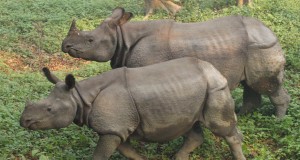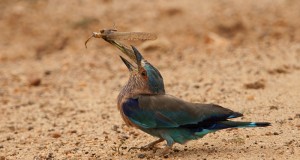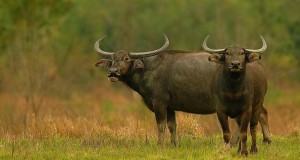Only 110 miles (176 km) from Delhi and 31 miles (50 km) west of Agra and the Taj Mahal, Keoladeo Ghana is a wonder of the natural world no less worth seeing than the marble tomb of Shah Jahan’s queen. Over 350 species of birds find a refuge in the 11 sq miles (29 sq km) of shallow lakes and woodland which make up the park. A third of them are migrants many of whom winter in Bharatpur before returning to their breeding grounds as far away as Siberia and Central Asia. Some 120 species nest in the park and the heronry at Keoladeo Ghana is said to be one of the finest in the world. The park is open throughout the year although most visitors choose to come between the months of October and March when wintering wildfowl assemble in their thousands on the lakes or jheels .
History: While many of India’s parks have been developed from the hunting preserves of princely India, Keoladeo Ghana is perhaps the only one where the habitat has been created by a maharaja. The park, a mile or so from Bharatpur town, still commonly known as “Bharatpur” rather than by its official name, is the handiwork of the royal family of Bharatpur. The maharaja developed the area in the late 19th Century. Until then it was no different from the arid scrub woodland of the surrounding countryside except that it formed a slight depression which collected rainwater during the monsoon and attracted wildfowl for the period before it dried up. The maharaja recognized the area’s potential and augmented the water supply by diverting water from a nearby irrigation canal. He also constructed small dams, dykes and shooting butts to turn the area into the finest wildfowl hunting preserve in north India. In a few years the new ecosystem so flourished that it was able to support thousands of water birds.
The maharaja celebrated his success in style, with extravagant shooting parties for the dignitaries of British and princely India. Their exploits are recorded to this day on a sandstone inscription in the park.
Perhaps surprisingly, the birds survived these depradations and still came to Bharatpur in huge numbers. In 1956 the hunting preserve became a sanctuary, but the VIP shoots continued until 1964 and the maharaja himself retained his personal shooting rights until 1972.
The end of the shooting parties did not mean the end of Bharatpur’s problems. The viceroys and maharajas were replaced by unruly tourists with transistor radios and hundreds of domestic cattle and buffaloes belonging to local villagers. In order to control these problems Bharatpur was upgraded to a national park in 1981 and renamed Keoladeo Ghana. Keoladeo is the name of the ancient Hindu temple devoted to the god Shiva which stands in the center of the park. “Ghana” means dense, referring to the thick forest which used to cover the area.
Geography and Habitat: Keoladeo Ghana lies 1214 feet (370 meters) above sea level and, besides the wetland for which it is famous, contains various other habitats from woodland, scrub and pasture to denuded saline patches. The lakes are fed entirely by rain and river water brought by canal from the Gambhir and Banganga rivers. In the monsoon some four square miles (11 sq km) of the park can be inundated. One waterway, the Ghana Canal, bisects the park, running northeast to northwest.
One main metaled road runs through the center of the park from the northern entrance, through the main wetland area on the eastern side of the park, where it follows the course of the Ghana Canal. At intervals along the road raised paths lined with Kabul trees (Acacia nilotica) lead off into the wetland. Babuls are the dominant tree in the park and these paths and undergrowth along them provide excellent blinds for birdwatching. There are many good paths in the park and several trails, beginning and ending at various points on the road, are recommended to visitors.
Bharatpur forms part of the vast Indo- Gangetic plain and its climate is therefore hot in summer (max 116°F/47°C, min. 95°F/35°C), humid in the monsoon (July September) and comparatively cool in the winter (max 95°F/35°C, min 41°F /5°C), becoming quite chilly at night.
Average annual rainfall is 26 inches (66 cm). Flora: Keoladeo Ghana contains a bewildering variety of flora representing 64 families, 181 genera and 227 subspecies. Besides the babul, other native species of tree include ber, kalam, khajur and khejri. Dozens of species of grasses and reeds abound, providing rich grazing for birds and mammals alike. The wetland habitat of the park has been described by the naturalist, Anne Bastille, as “a living soup of frogs, toads, water snakes, snails, leeches, turtles, pondweeds, carp, water hyacinth, catfish, water beetles, duckweed, lilies, protozoans, wild celery and plankton.” Even this description is by no means a comprehensive list of ingredients. Among the fish are rohu (Labeo rohita), bata ( Laheo hata), calbasu (Laheo calhasu), catla ( Cana nirigal ( Cirrhina mrigal) and sarana ( Barhus sarana). Some grow to a good size and a 33 lb. (15 kg) sarana has been caught in the park. Predatory fishes include murrel ( Ophocephalus stricture ) and freshwater shark ( Wallah attu).
Visiting the Park: Although many people visit Bharatpur for the day, it is recommended to stay at least one night in one of the hotels which provide simple accommodation within or just outside the park.
This gives the visitor the chance to see Keoladeo Ghana at its best — in the early morning and evening. Entry tickets to the park are available at its main entrance. One can drive motor vehicles from the entrance as far as the Forest Lodge and the offices of the warden located in Shanti Kuhr, formerly a hunting lodge of the maharaja. However, from there on, the only vehicles allowed arc bicycles and cycle rickshaws. Both are available on hire from the Forest Lodge and the “rickshaw wallahs” take a genuine interest in the birdlife and have been trained to recognize the different species. Boats are also available to take groups of visitors on a circular tour of the wetland starting from the jetty near Shanti Kutir, and a boat trip shortly after dawn is perhaps the most enchanting introduction to the park.
At the start of the peak tourist season in October the heronries are still occupied, although breeding begins shortly after the onset of the monsoon. Thousands of birds nest together in mixed heronries, dominated by different species in different parts of the sanctuary. Some of the most spectacular heronries are situated near the road and can be approached by the raised paths running off it. The crowded and noisy colonies are constructed in habul trees which stand halfsubmerged in water. As many as eight or nine species of birds may nest in one tree. Painted storks, white ibis, openbills, spoonbills, egrets, herons, cormorants and shags are in abundance, while thousands of moorhens and jacanas breed in thee floating vegetation on the water surface. The amount of food necessary to support the heronries is enormous. It’s been estimated that 2,000 painted storks breeding in an area of no ‘more than a square mile (2.5 sq km) require four six tons of food each day to support themselves and their nestlings. In the 30 to 40 days they breed they consume at least 1200 tons of food — and this is only one section of the population of one species breeding in the park. The painted storks, like many other birds in Bharatpur during the monsoon, are local migrants which come to the park between July and October to breed.
In October birds from further afield gradually begin to arrive. Among the ducks, geese and waders that come to Keoladeo Ghana are gadvval , wigeon, shovelers, garganey, marbled, common and falcated teal, and the red-crested, common and white-eyed pochard. Unmistakable as they fly overhead arc the musical whistling teal. Greylag and bar-headed geese also appear in large numbers and waders include various species of plover, sandpiper and snipe. Two species of pelican, the rosy and dalmatian, join the resident gray pelican.
In recent years the Bombay Natural History Society Las . been ringing birds at Keoladeo Ghana. Common teal, garganey and wigeon have been recovered in the USSR as far as 2858 miles (4600 km) away. A shoveler was found in Samarkand, and ruff and reeve as far as 3635 miles (5850 km) away in Yakutian in the USSR. The ringing operation has also provided evidence which has helped to prove that Keoladeo Ghana is a staging post for many migrants who build up their reserves of fat in the park before departing for their final destinations in places such as South India.
Besides the waterfowl, there are many terrestrial migrant species. Warblers, pipits, wagtails and buntings are also winter visitors. But of all the migrants the most sought after is the Siberian crane.
There are only two wintering places left for the western race of this extremely rare species. One is in Feredunkenar in Iran and the other is Keoladeo Ghana. The journey to Bharatpur takes them 3977 miles (6400 km) from their breeding grounds in Siberia. They arrive in December and stay until early March. These impressive, pure-white birds, with their black primaries and crimson bills and facial patches, are one of four types of crane in the sanctuary. The demoiselle and common cranes too are visitors, the sarus being the only resident. Unlike other Indian cranes, the Siberian crane is entirely vegetarian. It feeds on underground aquatic roots and tubers in loose flocks of five or six. Some birds, however, remain in their breeding pairs and establish their own territories. They see off intruders with a spectacular display, throwing their heads backwards and forwards, accompanied by loud crie . These pairs often have one chick with them on arrival whose immature brown and white plumage changes to pure white and black during the winter. The inability of these cranes to produce more than one chick is one reason given for their scarcity.
Although Siberian cranes had been known to visit India for centuries (Ustad Mansur, a court artist of the Emperor Jahangir, made a detailed painting of the crane in the 17th century), it has never been a common species.
Many species at Bharatpur are specialist feeders like the Siberian crane. It is this which allows so many birds to flourish in such a small area. Each helps itself to one ingredient of the wetland soup. Flamingos sieve the water for plankton, spoonbills rake the mud with their lower mandibles for mollusks, tadpoles and weed, while egrets and herons spear their prey, and geese and brahminy ducks graze at the water’s edge.
An indication of the strength of the food chain in the sanctuary is the number of birds of prey, migratory and resident, which it contains. At least 32 species of birds of prey and seven species of owl have been observed. Among notable migrants are the steppe eagle, pale and marsh harriers, osprey and peregrine falcon. Resident Indian species are no less striking. These include the tawny eagle, ring-tailed fishing eagle, crested serpent eagle, and Brahminy and blackwinged kites. Four species of vulture can be seen, notably the less common king or black vulture.
The migrants leave for their breeding grounds around March, when many of the small, terrestrial birds in the park are preparing to nest. Even without the migrants, there are many birds still to be seen and, although the spectacle of the winter season is missing, the visitor has the pleasure of having the park more or less to himself. Egrets, herons, cormorants, storks, plump purple moorhens and elegant pheasanttailed jacanas are all residents. Pied kingfishers hover dramatically overhead before plunging into the water after their prey and darters perch like cormorants, hanging their wings out to dry. In the hot weather, before the monsoon breaks, red-wattled lapwing and stone curlew hatch their eggs in wellcamouflaged nests on the ground, and pairs of sarus cranes, seen in India as symbols of fidelity, perform their courtship dances. Terrestrial birds too are in abundance. At the onset of the monsoon, weaver birds begin to construct their elaborate pendulous nests from date palms and other trees.
Mammals and Pythons: The most easily sighted of the mammals at Keoladeo Ghana (besides the lively little ground squirrels) are the sounders of wild boar which root around the jungle near the Forest Lodge and in thickets. Sambar and nilgai can be seen near or in the shallow waters of the wetland, although chital or spotted deer are restricted to the park’s dry areas towards the south and west. There is also a small population of blackbuck. Rhesus macaques and langurs are present but not encouraged by the authorities. The common mongoose can often be seen running across the road or in the undergrowth at its edges, and smooth otters are another attractive and entertaining animal to look out for on the lakes.
Three types of wild cat, the jungle, leopard and fishing cat, are present as are the Indian and common palm civets. Jackals can be very vocal at night and striped hyenas, foxes, porcupine, hare and a variety of smaller mammals have also been seen. A bonus to visitors fond of reptiles are the large rock pythons which can be seen sunning themselves, especially at Python Point beyond the Keoladeo Temple.





